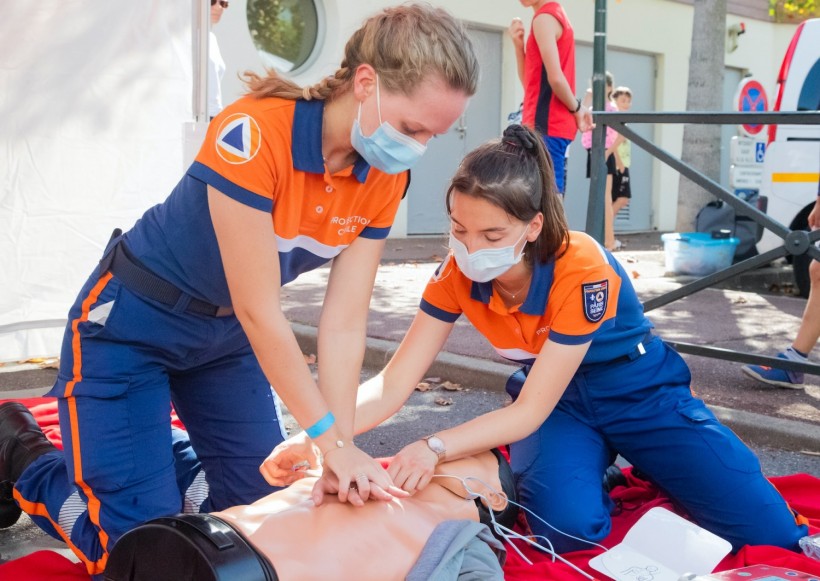
(Photo : Michel E on Unsplash)
CPR renewal is essential for maintaining lifesaving skills and ensuring that you are up-to-date on the latest techniques.CPR renewal courses are important for maintaining proficiency in lifesaving skills and keeping up-to-date with the latest techniques.
CPR is a crucial component of emergency care and can make a significant difference in saving lives when administered correctly. When researching CPR renewal options, individuals may wonder whether online classes, in-person classes, or a combination of both would be the best option. Laid out below are some pros and cons of each method.
In-Person Classes
Pros
Renewing CPR certification through in-person classes provides an invaluable advantage of receiving practical training from certified instructors who offer real-time feedback and can answer any questions. This type of training is especially beneficial to the ones requiring extra support or clarification regarding the course content. Moreover, taking part in a face-to-face class enables students to simulate emergency situations with fellow trainees, allowing for a realistic hands-on experience that cannot be easily replicated online or through videos alone.
Cons
In light of the ongoing COVID-19 crisis and busy schedules, attending in-person CPR classes can pose several challenges for some individuals. Not only are they often limited in availability and scheduling options, but they also come with higher costs due to additional training expenses. Moreover, lengthy courses can be time-consuming and may impact one's ability to meet other responsibilities effectively.
Online CPR education addresses these issues by offering flexible learning hours that do not disrupt a person's work-life balance while eliminating pandemic-related concerns associated with physical attendance at traditional instructor-led classes. By embracing online CPR training programs, you gain access to high-quality coursework tailored to your individual needs without any compromise on skill acquisition or certification excellence, as demonstrated by research studies concluding its effectiveness on par with conventional classroom-based instruction methods.
Online Classes
Pros
Online CPR education offers several benefits, including flexibility and consistency in coursework delivery, as well as increased accessibility to remote populations. Many nurses even decide to get online degrees in nursing because of their flexibility. Moreover, online CPR courses eliminate the issue of instructor variability, which poses a challenge in traditional in-person classes.
An online CPR course also offers the convenience of being able to access coursework from virtually anywhere and at any time. Additionally, studies have shown that online-only CPR courses are as effective in improving CPR skills as traditional classroom-based courses. Overall, online CPR education provides a flexible and convenient option for individuals seeking to acquire life-saving skills.
Cons
However, it is important to note that online CPR courses may not be suitable for everyone. Learners who prefer hands-on experience and interaction with live instructors may find online education lacking in this aspect. Additionally, some learners may have technical challenges related to internet connectivity or accessing the course modules. Therefore, it is important for learners to evaluate their learning styles and preferences before choosing an online CPR course. Furthermore, it is essential to ensure that the online CPR course provider is accredited and reputable to avoid falling victim to scams or inadequate training.
Blended Learning
Pros
By utilizing a combination of online and traditional in-person instruction, blended learning courses offer the best of both worlds. This pioneering approach not only provides learners with the convenience of completing coursework on their own schedule but also hands-on experience under live instructors. According to research studies, it has been proven that blended learning CPR courses are as competent - if not more than conventional classroom-based training methods required for certification purposes.
Moreover, this innovative method caters to varying preferences and diversified learning styles, offering learners increased adaptability and flexibility without compromising on quality or effectiveness.
Cons
However, blended learning courses may pose some challenges for individuals who have limited access to technology or lack the necessary equipment required to complete online coursework. Additionally, blended learning courses may require more time commitment from learners as they have to attend in-person sessions on top of online coursework. It is important to carefully consider one's personal circumstances and needs before enrolling in a blended learning CPR course.
Conclusion
To summarize, there are multiple options available for individuals who wish to learn CPR skills. Online learning and blended learning both offer flexible choices that cater to various needs. While online learning offers the advantages of accessibility and convenience, blended instruction combines in-person teaching with digital resources.
However, it is prudent for learners to reflect on their personal preferences before selecting a suitable course option. Besides this, verifying the accreditation and quality of instructors is essential for receiving comprehensive training. Ultimately, choosing between online or blended CPR courses depends on individual circumstances that need careful consideration based on one's academic background preference and skill level requirements.
* This is a contributed article and this content does not necessarily represent the views of hngn.com








